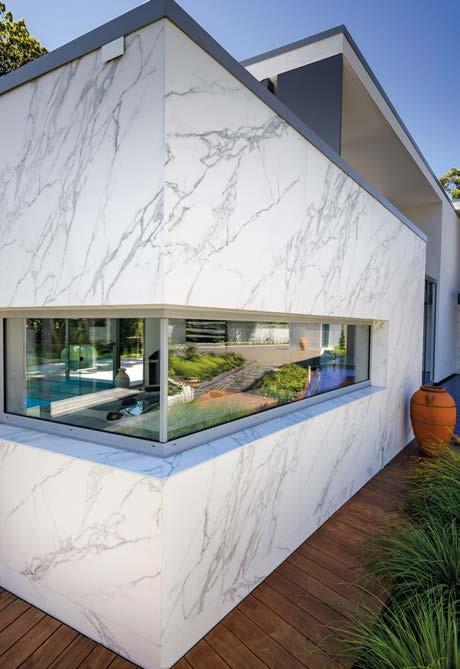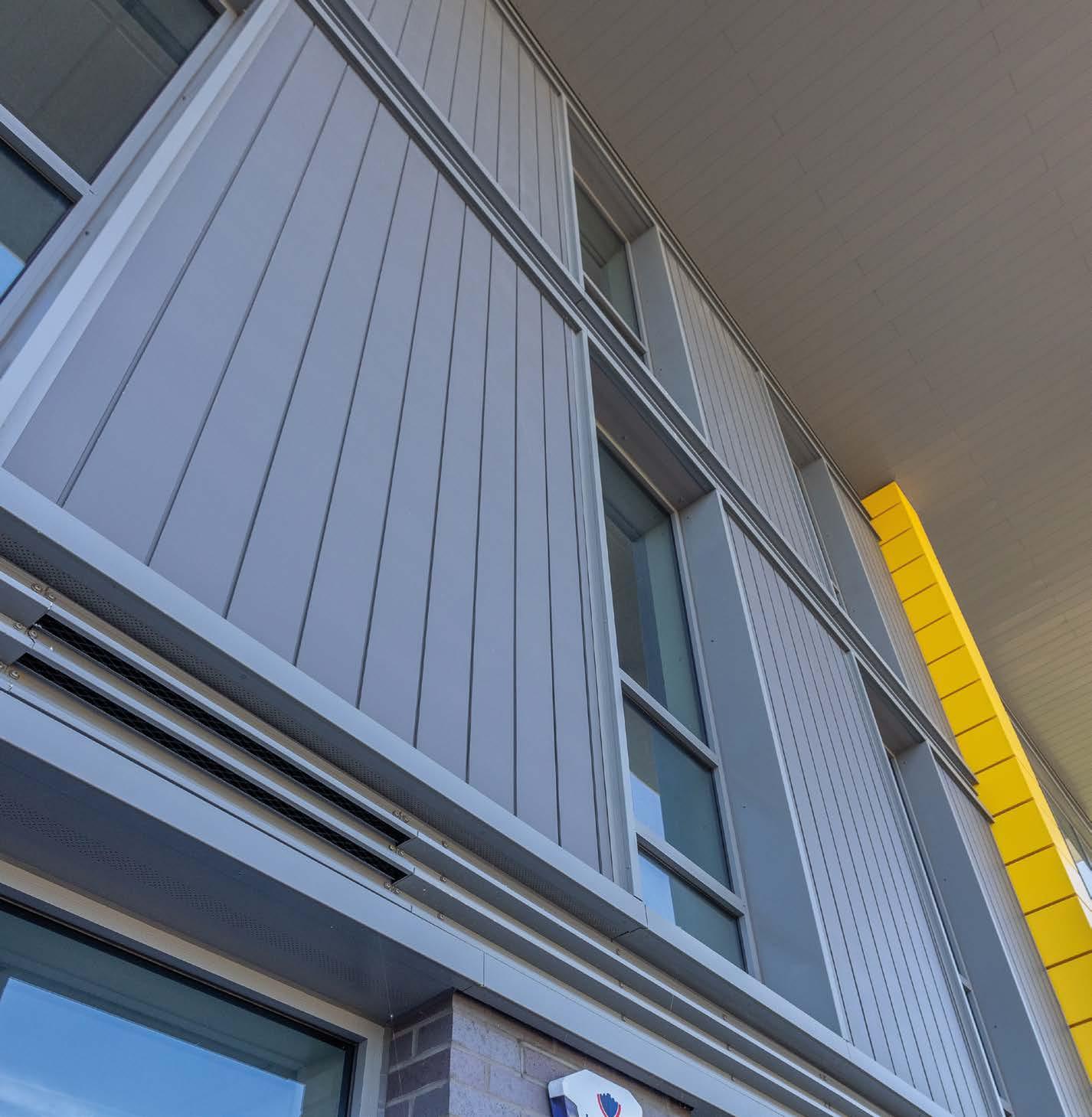
11 minute read
Neolith achieves carbon neutral status


Market-leading surfacing brand goes carbon neutral.
The pioneers of Sintered Stone has announced it has achieved carbon neutral status.
In 2019 the brand recorded no net release of carbon dioxide into the atmosphere from gate-to-gate emissions.
It’s a significant milestone in the company’s objective to become an internationally recognised green manufacturer, producing one of the most sustainable and ecologicallyfriendly materials available to architects, specifiers and end users alike.
WORKING OUT
To attain the highly-prized carbon neutral status Neolith followed the internationally recognized Greenhouse Gas Protocol (GHGP) and implemented a dynamic, innovationled sustainability strategy coupled with tactical, high value carbon-offsetting.
This has led to carbon neutrality across the entire business, significantly seeing the brand receiving 100% of its electricity in 2019 from renewable energy sources. This measure removed a massive 7,690 tonnes of CO2 emissions .


Furthermore 90% of the waste generated by Neolith is recycled and given a second life either with company operations or through authorized 3rd party players. This demonstrates a robust commitment to the circular economy.
Neolith’s surfaces also embody these principles, with up to 48% of slab composition obtained from recycled material .
Plant machinery has been upgraded to improve energy efficiency, particularly the 3rd line’s furnace which has benefitted from the installation of an O2 and pressure control system, significantly reducing the amount of gas consumed.
This is complemented by a 40% reduction of forklift truck diesel consumption and a 20% decrease in hazardous waste.
A policy to reduce the amounts of single-use plastic used has also been implemented. A small, but significant step towards carbon neutrality, demonstrating Neolith’s commitment to sustainable business.

All these measures directly meet GHG’s reduction objectives, which include: direct emissions company activity (e.g. natural gas, gasoil used in forklifts, cars in property), emissions from electricity used and other indirect emissions, generated from other day to day company activity.
Fundamentally, Neolith is an organisation with eco-friendly and sustainable practices at the heart of the business.
MAKING A DIFFERENCE
In terms of carbon offsetting, Neolith has also undertaken a number of environmental projects, in line with its wider sustainability strategy. These projects compensate for and absorb a specific quantity of CO2e. Chief amongst these is an exciting, upcoming project in Central America to protect and maintain the unique biodiversity of the Guatemalan Caribbean Conservation Coast.
Specifically, the Guatemalan Caribbean Conservation Coast project will see Neolith working to protect the unique biodiversity within the remaining forests in the region. The brand will help to address the drivers of deforestation through effective law enforcement, land use planning, education, economic opportunities and sustainable agroforestry initiatives.





As a direct result of the project activities, over four million tCO2e will be avoided by 2021, the equivalent of taking over 440,000 homes off the grid for a year. When considering the lifetime of the project over 30 years, the tCO2e avoided will be closer to c. 22 million. There are also important biodiversity benefits, protecting over 400 species of birds have been documented in the project and the habitat of an abundance of mammals and reptiles, including 30 High Conservation Value (HCV) species.

Commenting on the announcement Mar Esteve Cortes, Neolith’s CMO, says, “Given the brand’s founding vision, achieving carbon neutrality represents the achievement of a core company objective. I’m proud that architects, designers and consumers can choose Neolith’s surfaces, confident they are investing in the greenest Sintered Stone available. This will make their projects even more eco-friendly.” José Luis Ramón, Neolith’s CEO, adds, “Corporate social responsibility is not only about ensuring your business practices are as sustainable and ethical as possible, it’s also about giving back to wider society. Particularly, helping others less fortunate than yourself. Our work on Guatemalan Caribbean Conservation Coast project will have myriad benefits, not only for this unique region’s biodiversity but also the people who live there. It will strengthen the natural habitat and provide a much needed socio-economic boost to the local population, which is one of the poorest in Central America.”
To find out more about Neolith’s sustainability activities and projects, visit www.neolith.com/en/carbon-neutral.
PASSIVE COOLING THERMAL ENERGY STORAGE
WHY BUILDING ENVELOPE TES?
PCMs can be selected so that they freeze and melt at the appropriate temperature to ensure that the building doesn’t overheat or overcool. By introducing PCM into the building envelope it is possible to vastly increase the thermal mass of a building, helping ensure that rooms are maintained within the thermal comfort zone.

By installing PCM modules inside the building fabric itself, the end-users gain the thermal and performance benefits of PCMs without even being aware that they are in place.

As the PCM module is a static system with no moving parts the passive cooling concept is considedred to be a maintenance and energy free option for improving the internal conditions of any built environment applications.
BUILDING APPLICATIONS

Air Conditioning
Free Cooling
Passive Cooling
Fabric TES

Solar Systems
Tri-generation
Electronic / Shelter Cooling


Passive cooling takes advantage of the naturally occurring temperature swing caused by day & night. The excess coolth available in the night can be stored in the PCM, which is then released during the day, absorbing internal and solar heat gains.
ThinICE modules can be installed at high levels so that heat goes up but doesn’t come back down. This cooling effect can provide relief to building inhabitants or for electronic equipment.
If the site is located in a region where there are large daynight temperature swings, then it is possible to provide free cooling by ventilating the room at night to freeze the PCM modules by the morning. The size of the cooling machinery could then be greatly reduced leading to lower emissions, reduced maintenance costs and reduced operational costs.
For a standard 595x595mm ceiling tile, two ThinICE modules can be installed offering up to 0.96 kWh/m2 of energy storage. At an installed weight of up to 24kg/m2, most suspended ceilings are more than capable of handling this additional load. These are ideally fitted above a perforated metallic suspended ceiling. For more lightweight systems contact our sales team.

This also offers load-shifting capabilities. Load shifting is a strategy, where a proportion of the peak cooling capacity of a system is shifted into off-peak periods.
The benefit of shifting cooling into the nightly off-peak is twofold, firstly it is possible to gain access to cheaper electricity tariffs and secondly, the refrigeration equipment can be operated in lower ambient conditions leading to a higher COP.
Info@pcmproducts.net +44 (0)1733 245511 www.pcmproducts.net


ACTIVE COOLING WITH A PASSIVE SAFETY NET

It’s easy to upgrade these passive cooling systems into an active chilled ceiling. This greatly improves the flexibility of a conventional HVAC system. Should, for any reason the HVAC machinery fails the frozen PCM modules offer an uninterruptable emergency relief cooling system giving the facility maintenance team an opportunity to react.




MANUFACTURERS ARE CRUCIAL FOR ACHIEVING NET ZERO
FUTUREBUILD CALLS ON THE BUILT ENVIRONMENT SUPPLY CHAIN TO TRANSFORM THE INDUSTRY
Futurebuild is calling for manufacturers to join contractors, architects, engineers and more across the built environment supply chain in taking a critical role to achieve net zero carbon emissions. At the event, from March 2 to 4, 2021 at ExCeL London, exhibitors and visitors can debate issues, share ideas and showcase products to tackle the generation’s greatest challenge — the climate and ecological crisis.
In 2020, the pandemic meant that many events for the built environment industry to meet and collaborate were either postponed or cancelled. We know that we cannot pause our progress in transforming the sustainability of the industry, so Futurebuild 2021 will be going ahead.
Our industry currently faces two main challenges — recovery after the current pandemic and achieving net zero carbon. The Chancellor’s recent announcement of £3bn in funding to reduce emissions generated by current infrastructure brings us closer to the UK’s target of net zero by 2050, but is it enough to transform the industry?
According to research, 85 per cent of the infrastructure we’ll have in 2050 will have been built by 2030. Some even say that construction will need to transform itself by 2025. So, we have five to ten years to make the fundamental changes required to radically reduce carbon emissions. We must act now. “Futurebuild is the platform to debate current issues, exchange best practice and showcase the solutions and technologies that can really drive change,” explained Martin Hurn, event director of Futurebuild. “The Government’s plan for green recovery is a good first step, but so much more is needed. We know that the entire supply chain must work together to make a real difference. Specifiers have the power to transform the industry — it is their products that drive our green infrastructure capabilities.”

Futurebuild, previously Ecobuild, has led the way in tackling climate change in the construction industry for over ten years. The event brings together over 20,500 industry influencers to debate ideas, showcase products and drive real change across the built environment. For example, 73 per cent of visitors in 2020 reported that they attend the show with the intent to see and invest in the latest innovations and product launches.
In 2021, the event’s stages will put a spotlight on six key areas to support industry transformation — whole house retrofit, digital impact, future installer, district energy, circular materials and intelligent buildings.
Are you a manufacturer that has ideas or technologies, new or existing, that can improve sustainability and help us meet net zero carbon? Net zero needs you to showcase it.
Register your interest to exhibit at Futurebuild 2021 www.futurebuild.co.uk/visit/register-your-interest/

CUTTING-EDGE LUXURY DESIGN FROM AMARA PROPERTY

These developments are made even more impressive by the eco-credentials, as the industry’s focus grows on the importance of climate change, Amara Property leads the way by identifying innovative ways to ensure sustainability sits at the core of its design approach.
Smart build techniques such as opting for recycled materials and increasing the construction fabric of the building dramatically minimises waste, while the installation of solar roof panels and Ecotricity meters creates long-term low carbon footprint homes. By further harnessing this green energy through the use of Tesla Power Walls, from which devices can be charged using stored solar power, electricity costs at its Kingwood development in Hadley Wood were reduced to as little as £6 per month.
Winner of an International Property Award, Amara Property’s latest build, Aria, is an enviable £5million flagship home in Hadley Wood that pushes the boundaries of architectural construction and fuses luxurious living with state-of-theart technology. Designed with entertainment in mind, the property features an expansive basement leisure complex that includes a home cinema with surround-sound system, games room, swimming pool complete with bar area, gym, steam and sauna rooms, all of which can be controlled remotely from a Gira central hub. Gira is an intelligent home automation system that Amara selected in line with its commitment to tech-focused design, allowing everything from temperature to security to be conveniently operated via a smartphone or tablet, proving yet another example of Amara Property’s attention to detail.

Aria is an exceptional property that perfectly exemplifies the company’s core vision of combining contemporary luxury, sustainable living and technology through both traditional and modern design techniques.
Currently, Amara Property are creating Waterside Mansions, a development of three exquisitely designed five-bedroom detached homes situated on Gordon Avenue - one of Stanmore’s most prestigious roads.
Blending luxurious family living with contemporary architecture and carefully crafted design, Waterside Mansions are created with Amaras values in mind, and offer the lucky residents elegant light-filled interiors where classic form meets stylish functionality, and lavish finishes blend seamlessly with a sense of relaxed refinement.










